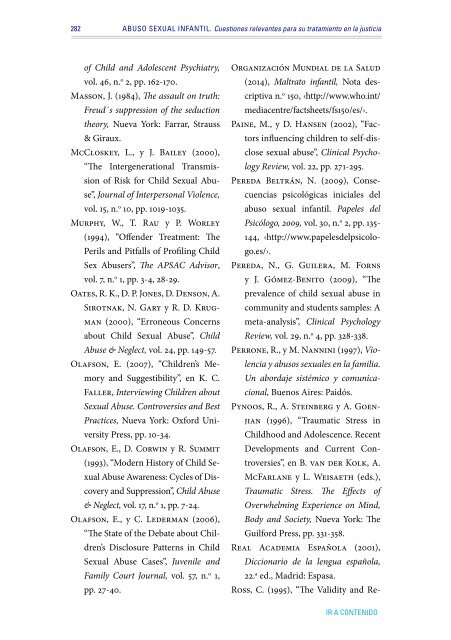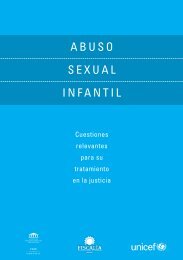Abuso_sexual_infantil_digital uruguay
You also want an ePaper? Increase the reach of your titles
YUMPU automatically turns print PDFs into web optimized ePapers that Google loves.
282 <strong>Abuso</strong> <strong>sexual</strong> <strong>infantil</strong>. Cuestiones relevantes para su tratamiento en la justicia<br />
of Child and Adolescent Psychiatry,<br />
vol. 46, n. o 2, pp. 162-170.<br />
Masson, J. (1984), The assault on truth:<br />
Freud´s suppression of the seduction<br />
theory, Nueva York: Farrar, Strauss<br />
& Giraux.<br />
McCloskey, L., y J. Bailey (2000),<br />
“The Intergenerational Transmission<br />
of Risk for Child Sexual Abuse”,<br />
Journal of Interpersonal Violence,<br />
vol. 15, n. o 10, pp. 1019-1035.<br />
Murphy, W., T. Rau y P. Worley<br />
(1994), “Offender Treatment: The<br />
Perils and Pitfalls of Profiling Child<br />
Sex Abusers”, The APSAC Advisor,<br />
vol. 7, n. o 1, pp. 3-4, 28‐29.<br />
Oates, R. K., D. P. Jones, D. Denson, A.<br />
Sirotnak, N. Gary y R. D. Krugman<br />
(2000), “Erroneous Concerns<br />
about Child Sexual Abuse”, Child<br />
Abuse & Neglect, vol. 24, pp. 149-57.<br />
Olafson, E. (2007), “Children’s Memory<br />
and Suggestibility”, en K. C.<br />
Faller, Interviewing Children about<br />
Sexual Abuse. Controversies and Best<br />
Practices, Nueva York: Oxford University<br />
Press, pp. 10-34.<br />
Olafson, E., D. Corwin y R. Summit<br />
(1993), “Modern History of Child Sexual<br />
Abuse Awareness: Cycles of Discovery<br />
and Suppression”, Child Abuse<br />
& Neglect, vol. 17, n. o 1, pp. 7-24.<br />
Olafson, E., y C. Lederman (2006),<br />
“The State of the Debate about Children’s<br />
Disclosure Patterns in Child<br />
Sexual Abuse Cases”, Juvenile and<br />
Family Court Journal, vol. 57, n. o 1,<br />
pp. 27-40.<br />
Organización Mundial de la Salud<br />
(2014), Maltrato <strong>infantil</strong>, Nota descriptiva<br />
n. o 150, ‹http://www.who.int/<br />
mediacentre/factsheets/fs150/es/›.<br />
Paine, M., y D. Hansen (2002), “Factors<br />
influencing children to self-disclose<br />
<strong>sexual</strong> abuse”, Clinical Psychology<br />
Review, vol. 22, pp. 271‐295.<br />
Pereda Beltrán, N. (2009), Consecuencias<br />
psicológicas iniciales del<br />
abuso <strong>sexual</strong> <strong>infantil</strong>. Papeles del<br />
Psicólogo, 2009, vol. 30, n. o 2, pp. 135-<br />
144, ‹http://www.papelesdelpsicologo.es/›.<br />
Pereda, N., G. Guilera, M. Forns<br />
y J. Gómez-Benito (2009), “The<br />
prevalence of child <strong>sexual</strong> abuse in<br />
community and students samples: A<br />
meta-analysis”, Clinical Psychology<br />
Review, vol. 29, n. o 4, pp. 328-338.<br />
Perrone, R., y M. Nannini (1997), Violencia<br />
y abusos <strong>sexual</strong>es en la familia.<br />
Un abordaje sistémico y comunicacional,<br />
Buenos Aires: Paidós.<br />
Pynoos, R., A. Steinberg y A. Goenjian<br />
(1996), “Traumatic Stress in<br />
Childhood and Adolescence. Recent<br />
Developments and Current Controversies”,<br />
en B. van der Kolk, A.<br />
McFarlane y L. Weisaeth (eds.),<br />
Traumatic Stress. The Effects of<br />
Overwhelming Experience on Mind,<br />
Body and Society, Nueva York: The<br />
Guilford Press, pp. 331-358.<br />
Real Academia Española (2001),<br />
Diccionario de la lengua española,<br />
22. a ed., Madrid: Espasa.<br />
Ross, C. (1995), “The Validity and Re-



